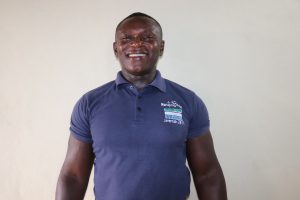Kamara Street is one of the most known streets in the Masoila community. The once tree-filled community is now busy with new houses built every day. There are more two-story buildings now than ever before due to the lack of space. Houses are built very close to each other, with no room for additional structures.
The trees used to be of great help in containing the water during the rainy season. However, the lack of trees has caused soil runoff during the rains. The community added street gutters to divert all rainwater to the swamp at the lower end of Kamara street.
The primary well for people living here is located on the left side of the road leading to the lower half of Kamara Street. The responsibility of bringing water into the household rest solely on the children and women. Very early in the morning, one can hear the crowing of chickens to alert everyone in the community it is time to get up. Lines are started as early as 6 in the morning, with people coming from far to get a bucket of the early morning water reserved for drinking.

As a community, water challenges have increased in recent years. The main well that provides for 300 people in this area runs dry at various points throughout the year. The closest alternative water source is a hand-dug well with a hand pump that is opened to contamination because it has no perimeter fence to restrict animals like dogs and goats. The community used to have several hand-dug wells that provided water all year round, but many are open to contamination or no longer work due to climate change.
Here’s what we’re going to do about it:
Well Rehabilitation
The well marked for this overhaul is dry for a few months every year and needs major work to supply adequate, clean water to the community year round. The pump will be removed, and a hand auger will be lowered inside and powered by a drill team. This hand auger will allow the team to drill several meters deeper to hit a sufficient water column that will ensure the well supplies water throughout all seasons.
As the team drills, casing will be installed, transforming the bottom of this hand-dug well into a borehole. PVC piping will connect this lower system directly to the pump, a construction that we know will also improve the quality of water.
Once this plan is implemented, everyone within the community will have access to safe drinking water in both quality and quantity, even through the dry months.
Hygiene and Sanitation Training
There will be hygiene and sanitation training sessions offered for three days in a row.
After our visit, the hygiene and sanitation trainer decided it would be best to teach community members how to build a tippy tap (a hand-washing station built with a jerrycan, string, and sticks). They will use these tippy taps for handwashing demonstrations, and will also teach about other tools like dish racks and the importance of properly penning in animals.
These trainings will also strengthen the water user committee that manages and maintains this well. They enforce proper behavior and report to us whenever they need our help solving a serious problem, like a pump breakdown.

 Borehole Well and Hand Pump
Borehole Well and Hand Pump


































